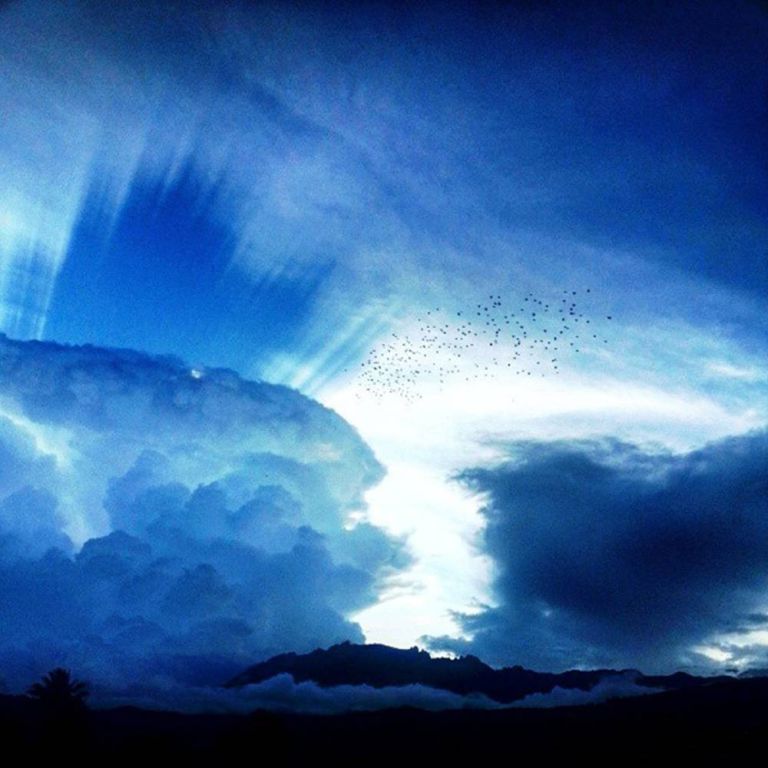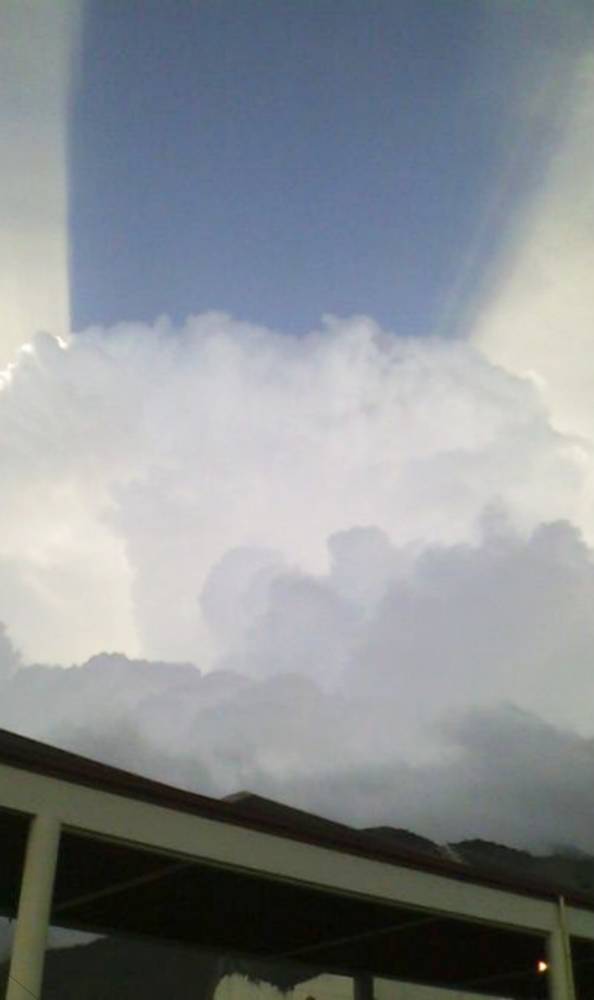It looks like you're using an Ad Blocker.
Please white-list or disable AboveTopSecret.com in your ad-blocking tool.
Thank you.
Some features of ATS will be disabled while you continue to use an ad-blocker.
14
share:
You've likely heard about that many Malayasians, including officials, blamed a group of 10 mountain climbers for a magnitude-5.9 earthquake earlier
this month. The claim being that the tourists acted disrespectfully by disrobing and posing for pictures on sacred Mt. Kinabalu, drawing the ire of
the gods.
What you may not have read is that six days after the June 5th earthquake, many observers captured images a short-lived phenomenon consisting of mysterious cobalt rays appearing above Mt. Kinabalu. Though referred to as a "blue rainbow," the mysterious lights more closely resemble brush strokes.
Here are three of the best images from social media:



Though it seems that some locals viewed the rays as further indication of the gods' anger, the lights were likely an example of a poorly understood phenomenon known as "earthquake lights."
From Wikipedia:
Several mechanisms have been proposed and its possible that lights have different origins but in every case, they do seem to be closely associated with particularly strong seismic activity.
Sources (info & images):
Express UK
The Star
Metro UK
What you may not have read is that six days after the June 5th earthquake, many observers captured images a short-lived phenomenon consisting of mysterious cobalt rays appearing above Mt. Kinabalu. Though referred to as a "blue rainbow," the mysterious lights more closely resemble brush strokes.
Here are three of the best images from social media:



Though it seems that some locals viewed the rays as further indication of the gods' anger, the lights were likely an example of a poorly understood phenomenon known as "earthquake lights."
From Wikipedia:
The lights are reported to appear while an earthquake is occurring, although there are reports of lights before or after earthquakes, such as reports concerning the 1975 Kalapana earthquake.[1] They are reported to have shapes similar to those of the auroras, with a white to bluish hue, but occasionally they have been reported having a wider color spectrum. The luminosity is reported to be visible for several seconds, but has also been reported to last for tens of minutes. Accounts of viewable distance from the epicenter varies: in the 1930 Idu earthquake, lights were reported up to 70 miles (110 km) from the epicenter.[2] Earthquake lights were reportedly spotted in Tianshui, Gansu, approximately 400 kilometres (250 mi) north-northeast of the 2008 Sichuan earthquake's epicenter.[3] During the 2007 Peru earthquake lights were seen in the skies above the sea and filmed by many people[citation needed]. The phenomenon was also observed and caught on film during the 2009 L'Aquila[4][5] and the 2010 Chile earthquakes.[6] Video footage has also recorded this happening during the 9 April 2011 eruption of Sakurajima Volcano, Japan[citation needed]. The phenomenon was also reported around the Amuri Earthquake in New Zealand, that occurred 1 September 1888. The lights were visible in the morning of 1 September in Reefton, and again on 8 September.[7] A more recent appearance of the phenomenon, along with video footage of the incident, happened in Sonoma County of California on August 24, 2014.[8]
Appearances of the earthquake light seem to occur when the quakes have a high magnitude, generally 5 or higher on the Richter scale.[8] There have also been incidents of yellow, ball-shaped lights appearing before earthquakes.[9]
Several mechanisms have been proposed and its possible that lights have different origins but in every case, they do seem to be closely associated with particularly strong seismic activity.
Sources (info & images):
Express UK
The Star
Metro UK
edit on 2015-6-18 by theantediluvian because: (no reason given)
Thank you for this. I love to see the beauty in nature, while being reminded of it's power.
Makes me wonder if the crushing and movement of minerals is releasing some kind of energy that we do not fully understand yet. some believe Quartz
crystals have an ability to store energy at certain frequencies, hence the use of quartz crystals for keeping time in watches.
a reply to: theantediluvian
Nah, I call BS on this stuff--I see this all the time associated with distant thunderstorms that have the sun behind them. My thought is that the air is so humid (or full of mist at that altitude) that the light rays passing along the edge of the clouds is actually reflected by the moisture particles, allowing them to be visible while the moisture in the shadow of the cloud remains "invisible."
This has nothing to do with earthquakes, but rather is coincidental. Please note that all of the images you provided are associated with very thick, heavy storm clouds with the sun being behind them. It's similar to a light projector in a smoky room where part of the light is obscured.
Hopefully I'm making sense. If not...meh.
Nah, I call BS on this stuff--I see this all the time associated with distant thunderstorms that have the sun behind them. My thought is that the air is so humid (or full of mist at that altitude) that the light rays passing along the edge of the clouds is actually reflected by the moisture particles, allowing them to be visible while the moisture in the shadow of the cloud remains "invisible."
This has nothing to do with earthquakes, but rather is coincidental. Please note that all of the images you provided are associated with very thick, heavy storm clouds with the sun being behind them. It's similar to a light projector in a smoky room where part of the light is obscured.
Hopefully I'm making sense. If not...meh.
a reply to: SlapMonkey
You make a good point. I haven't been able to find a wider image, but they do look like crepuscular rays only inverted so perhaps what we're actually seeing is the space between very crepuscular rays — a shadow of sorts?
Like this I found on Google images:

You make a good point. I haven't been able to find a wider image, but they do look like crepuscular rays only inverted so perhaps what we're actually seeing is the space between very crepuscular rays — a shadow of sorts?
Like this I found on Google images:

edit on 2015-6-18 by theantediluvian because: (no reason given)
a reply to: Glassbender777
One word: Piezoelectric
Quartz crystals in watches are not used because they store energy, they are used because they swing at a certain frequency. Same reason why it´s used in RC devices.
One word: Piezoelectric
Quartz crystals in watches are not used because they store energy, they are used because they swing at a certain frequency. Same reason why it´s used in RC devices.
a reply to: verschickter
Right, quartz is used in electronic oscillators for timing circuits (in everything basically). What you left out is why that works, namely that mechanical deformation generates a current on the surface of the crystal and vice versa.
So while he's wrong in that he's thinking of them like a battery, he's actually not far off in that something like compression of quartz crystals in the Earth's crust could be responsible for earthquake lights.
Right, quartz is used in electronic oscillators for timing circuits (in everything basically). What you left out is why that works, namely that mechanical deformation generates a current on the surface of the crystal and vice versa.
So while he's wrong in that he's thinking of them like a battery, he's actually not far off in that something like compression of quartz crystals in the Earth's crust could be responsible for earthquake lights.
I think the lights are from electric and di electric magnetism.
And I also think the Sun is a generator, the universe an electric plasma, the ionosphere a Conductor and the Earth a Ground.
But yeah, the #s unexplainable
And I also think the Sun is a generator, the universe an electric plasma, the ionosphere a Conductor and the Earth a Ground.
But yeah, the #s unexplainable
a reply to: theantediluvian
While I find those photos quite beautiful, living in CA on 4 faults, one being the famous and active San Andreas fault for over 5 decades, I have experienced many, many earthquakes and not one earthquake rainbow.
While I find those photos quite beautiful, living in CA on 4 faults, one being the famous and active San Andreas fault for over 5 decades, I have experienced many, many earthquakes and not one earthquake rainbow.
That's a lot better guess than "earthquake lights".
originally posted by: theantediluvian
a reply to: SlapMonkey
You make a good point. I haven't been able to find a wider image, but they do look like crepuscular rays only inverted so perhaps what we're actually seeing is the space between very crepuscular rays — a shadow of sorts?
Like this I found on Google images:
As a result of the crepuscular rays ID it seems like more of an Earth topic than science and technology. The "earthquake lights" have been hypothesized but I don't know if they've ever been confirmed.
originally posted by: Glassbender777
Makes me wonder if the crushing and movement of minerals is releasing some kind of energy that we do not fully understand yet. some believe Quartz crystals have an ability to store energy at certain frequencies, hence the use of quartz crystals for keeping time in watches.
Not at all. Quartz crystals are used in oscillators because they have fairly stable piezoelectric behavior.
You apply an electric field, they flex. You remove the electric field, they return to their original position, creating a small current as they do. By sizing the crystal, and cutting it at the right axis, you have a mechanically resonant structure that can be "rung" by an externally applied signal. For an oscillator, you put the crystal into what's basically a positive feedback path on an amplifier.
But it doesn't "store energy at certain frequencies". Nothing does.
Yeah I have to agree...Most accounts of Earthquake Lights I've read about dont seem to match this phenomenon...Før instance this article news.nationalgeographic.com... explains that they come in many forms...Including the "ufo/ball lightening" type. It does mention some that look like " blue flames" but they seem to be close to the ground. Others just look like flashes or lightening....And I don't think any of them linger around too long, like the ones in these photos. I've seen the sky look like the photos here myself from time to time. I would hazard a guess that in this particular case it may be due to some extra dust in the atmosphere kicked up by the earthquake itself.
originally posted by: SlapMonkey
a reply to: theantediluvian
Nah, I call BS on this stuff--I see this all the time associated with distant thunderstorms that have the sun behind them. My thought is that the air is so humid (or full of mist at that altitude) that the light rays passing along the edge of the clouds is actually reflected by the moisture particles, allowing them to be visible while the moisture in the shadow of the cloud remains "invisible."
This has nothing to do with earthquakes, but rather is coincidental. Please note that all of the images you provided are associated with very thick, heavy storm clouds with the sun being behind them. It's similar to a light projector in a smoky room where part of the light is obscured.
Hopefully I'm making sense. If not...meh.
Those appear to be cloud shadows more than they appear to be rainbows created through the refraction of light through water or another substance
suspended in the atmosphere.
Cloud shadows have caught me off guard a few times and confused my mind not understanding what it was I was viewing at first.
These "Dark Air" threads have come up on these forums from time to time.
Cloud shadows have caught me off guard a few times and confused my mind not understanding what it was I was viewing at first.
These "Dark Air" threads have come up on these forums from time to time.
a reply to: theantediluvian
This is why I wrote the term Piezoelectricity so he can google it. What you find if you google it:
(Wiki)
It´s not like I don´t know this or hid it deliberatly. No bad intentions here.
This is why I wrote the term Piezoelectricity so he can google it. What you find if you google it:
(Wiki)
Piezoelectricity
Quartz crystals have piezoelectric properties; they develop an electric potential upon the application of mechanical stress. An early use of this property of quartz crystals was in phonograph pickups. One of the most common piezoelectric uses of quartz today is as a crystal oscillator. The quartz clock is a familiar device using the mineral. The resonant frequency of a quartz crystal oscillator is changed by mechanically loading it, and this principle is used for very accurate measurements of very small mass changes in the quartz crystal microbalance and in thin-film thickness monitors.
It´s not like I don´t know this or hid it deliberatly. No bad intentions here.
a reply to: theantediluvianThe first image looks as if had a blue filter applied or it was shot with a blue filter. The others
do not look out of the ordinary to me. Just different shades of gray.
a reply to: theantediluvian
They're very pretty! I'd love to know what causes them, of course, but they are pretty, nonetheless. It seems almost bizarre that people would blame someone taking photos for such a thing. I hope the climbers didn't get into trouble!
They're very pretty! I'd love to know what causes them, of course, but they are pretty, nonetheless. It seems almost bizarre that people would blame someone taking photos for such a thing. I hope the climbers didn't get into trouble!
Cobalt radiation perhaps and I too wonder if any machine makes the same radiation and what causes them and what it would mean. But scary nonetheless.
originally posted by: LadyGreenEyes
a reply to: theantediluvian
They're very pretty! I'd love to know what causes them, of course, but they are pretty, nonetheless. It seems almost bizarre that people would blame someone taking photos for such a thing. I hope the climbers didn't get into trouble!
The pictures simply show cloud shadows - formed in a similar way to crepuscular rays. Not that uncommon, especially when the sun is low in the sky
towards sunset. Seen a few myself more spectacular than those.
new topics
-
Stalker 2 - Review from a Veteran
Video Games: 2 hours ago -
Does anyone have a link to download apple pay for androids
General Chit Chat: 3 hours ago -
Most INSANE internet rabbit hole
Secret Societies: 3 hours ago -
Joe Rogan conspiracy (maybe)
ATS Skunk Works: 7 hours ago -
Results of the use of the Oreshnik missile system in Dnepropetrovsk
World War Three: 9 hours ago -
Nigel Farage now the Most Favoured UK Politician
Regional Politics: 11 hours ago
top topics
-
Little Johnny and Larry should team up
General Chit Chat: 17 hours ago, 13 flags -
Results of the use of the Oreshnik missile system in Dnepropetrovsk
World War Three: 9 hours ago, 12 flags -
Most INSANE internet rabbit hole
Secret Societies: 3 hours ago, 8 flags -
Nigel Farage now the Most Favoured UK Politician
Regional Politics: 11 hours ago, 4 flags -
Joe Rogan conspiracy (maybe)
ATS Skunk Works: 7 hours ago, 4 flags -
Will Us use alien technology to fight in ww3?
World War Three: 17 hours ago, 3 flags -
Stalker 2 - Review from a Veteran
Video Games: 2 hours ago, 2 flags -
Does anyone have a link to download apple pay for androids
General Chit Chat: 3 hours ago, 1 flags
active topics
-
-@TH3WH17ERABB17- -Q- ---TIME TO SHOW THE WORLD--- -Part- --44--
Dissecting Disinformation • 3361 • : xuenchen -
Results of the use of the Oreshnik missile system in Dnepropetrovsk
World War Three • 161 • : KrustyKrab -
President-Elect TRUMP Picks Former Florida A.G. PAM BONDI to be U.S. Attorney General.
2024 Elections • 59 • : VariedcodeSole -
Elon Says It’s ‘Likely’ He Buys Tanking MSNBC
Political Ideology • 76 • : Astrocometus -
Joe Rogan conspiracy (maybe)
ATS Skunk Works • 3 • : Shoshanna -
Does anyone have a link to download apple pay for androids
General Chit Chat • 7 • : lilzazz -
Montelukast affects brain, caused 5 year old to attempt suicide
Medical Issues & Conspiracies • 12 • : lilzazz -
Jaguar Rebrand Video Causes "WTF?" Moment - Seriously Weird
Automotive Discussion • 27 • : lilzazz -
Stalker 2 - Review from a Veteran
Video Games • 2 • : CriticalStinker -
President-Elect DONALD TRUMP's 2nd-Term Administration Takes Shape.
Political Ideology • 241 • : WeMustCare
14
